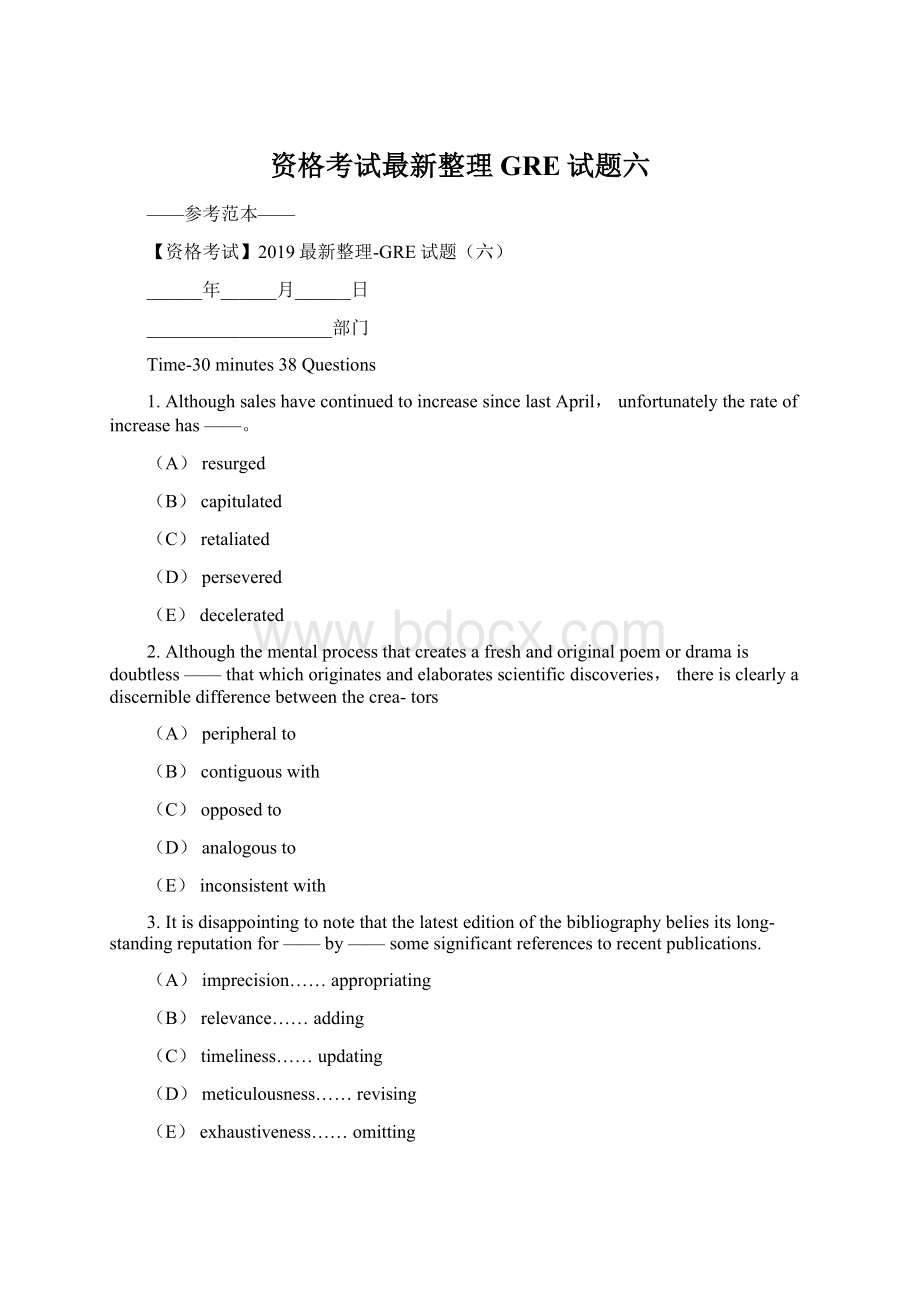资格考试最新整理GRE试题六Word文档格式.docx
《资格考试最新整理GRE试题六Word文档格式.docx》由会员分享,可在线阅读,更多相关《资格考试最新整理GRE试题六Word文档格式.docx(11页珍藏版)》请在冰豆网上搜索。

(C)timeliness……updating
(D)meticulousness……revising
(E)exhaustiveness……omitting
4.AlthoughSimpsonwasingeniousat——toappearinnovativeandspontaneous,beneaththeruseheremaineduninspiredandrigidinhisapproachtoproblem-solving.
(A)intending
(B)contriving
(C)forbearing
(D)declining
(E)deserving
5.Shewascriticizedbyherfellowlawyersnotbecauseshewasnot——,butbecausesheso——pre-paredhercasesthatshefailedtobringtheexpectednumbertotrial.
(A)wellversed……knowledgeably
(B)welltrained……enthusiastically
(C)congenial……rapidly
(D)hardworking……minutely
(E)astute……efficiently
6.Schlesingerhasrecentlyassumedaconciliatoryatti-tudethatisnot——byhiscolleagues,whocon-tinueto——compromise.
(A)eschewed……dread
(B)shared……defend
(C)questioned……reject
(D)understood……advocate
(E)commended……disparage
7.TheNationalArchivescontaininformationso——thatresearchershavebeenknownnevertopublishbecausetheycannotbeartobringtheirstudiestoanend.
(A)divisive
(B)seductive
(C)selective
(D)repetitive
(E)resourceful
8.HILL:
MOUNTAIN:
:
(A)grass:
rocks
(B)autumn:
winter
(C)creek:
river
(D)star:
sun
(E)cliff:
slope
9.AERATE:
OXYGEN:
(A)eclipse:
light
(B)desiccate:
moisture
(C)precipitate:
additive
(D)hydrate:
water
(E)striate:
texture
10.ORCHESTRA:
MUSICIAN:
(A)cube:
side
(B)kilometer:
meter
(C)sonnet:
poem
(D)biped:
foot
(E)pack:
wolf
11.EQUIVOCATION:
MISLEADING:
(A)mitigation:
severe
(B)advice:
peremptory
(C)bromide:
hackneyed
(D)precept:
obedient
(E)explanation:
unintelligible
12.CENSORSHIP:
COMMUNICATION:
(A)propaganda:
ideology
(B)preservative:
decay
(C)revision:
accuracy
(D)rest:
atrophy
(E)exercise:
fitness
13.BUS:
PASSENGERS:
(A)flock:
birds
(B)tanker:
liquid
(C)envelope:
letter
(D)bin:
coal
(E)automobile:
gasoline
14.BALLAD:
STANZA:
(A)novel:
chapter
(B)poem:
(C)play:
dialogue
(D)movie:
script
(E)photograph:
caption
15.DISABUSE:
FALLACY:
(A)cure:
disease
(B)persevere:
dereliction
(C)belittle:
imperfection
(D)discredit:
reputation
(E)discern:
discrimination
16.BLANDISHMENT:
CAJOLE:
(A)prediction:
convince
(B)obstacle:
impede
(C)embellishment:
praise
(D)deficiency:
compensate
(E)compliment:
exaggerate
Althoughthehormoneadrenalineisknowntoregulatememorystorage,itdoesnotpassfromthebloodintobraincells.Wearefacedwithanapparentparadox:
howcanahormonethatdoesnotactdirectlyonthebrainhavesucha(5)largeeffectonbrainfunction?
Recently,wetestedthepossibilitythatoneofthehormone‘sactionsoutsidethebrainmightberesponsible.Sinceoneconsequenceofadrenalinereleaseinananimalisanincreaseinbloodglucoselevels,weexaminedthe(10)effectsofglucoseonmemoryinrats.Wefoundthatglu-coseinjectedimmediatelyaftertrainingenhancesmemorytestedthenextday.Additionalevidencewasprovidedbynegativefindings:
drugscalledadrenergicantagonists,whichblockperipheraladrenalinereceptors,disrupted(15)adrenaline’sabilitytoregulatememorybutdidnotaffectmemoryenhancementsproducedbyglucosethatwasnotstimulatedbyadrenaline.Theseresultsareastheyshouldbeifadrenalineaffectsmemorymodulationbyincreasingbloodglucoselevels.
17.Theprimarypurposeofthepassageisto
(A)reconciletwoopposingtheories
(B)comparetwodifferentexplanationsforaphe-nomenon
(C)describeexperimentalresearchthatappearstosupportanunpopulartheory
(D)presentevidencethatmayhelptoresolveanapparentcontradiction
(E)describeahypothesisthathascauseacon-troversy
18.Itcanbeinferredfromthepassagethattheauthorwouldmostlikelydescribethe"
additionalevidence"
(line12)providedbyexperimentswithadrenergicantagonistsas
(A)revolutionary
(B)disappointing
(C)incomplete
(D)unexpected
(E)corroborative
19.Thepassageprovidesinformationaboutwhichofthefollowingtopics?
(A)Themechanismbywhichglucoseaffectsmemorystorage
(B)Theevidencethatpromptedscientisttotesttheeffectsofadrenalineonmemoryregulation
(C)Thereasonthattheeffectsofglucoseonmemoryweretested
(D)Thewaysthatmemorystoragemodifiesthestruc-tureofthebrain
(E)Thekindsoftrainingusedtotestmemoryenhance-mentinrats
20.Theauthorreferstotheresultsoftheexperimentusingadrenergicantagonistsas"
negativefindings"
(line13)
mostlikelybecausetheadrenergicantagonists
(A)failedtodisruptadrenaline‘seffectonmemory
(B)didnotaffectglucose‘sabilitytoenhancememory.
(C)didnotblockadrenaline‘sabilitytoincreasebloodglucoselevels
(D)onlypartiallyaffectedadrenaline‘sabilitytoenhancememory
(E)disruptedbothadrenaline‘sandglucose’seffectonmemory
Theageatwhichyoungchildrenbegintomakemoraldiscriminationsaboutharmfulactionscommittedagainstthemselvesorothershasbeenthefocusofrecentresearchintothemoraldevelopmentofchildren.Untilrecently,(5)childpsychologistssupportedpioneerdevelopmentalistJean.Piagetinhishypothesisthatbecauseoftheirimmaturity,childrenunderagesevendonottakeintoaccounttheinten-tionsofapersoncommittingaccidentalordeliberateharm,butrathersimplyassignpunishmentfortransgressionson(10)thebasisofthemagnitudeofthenegativeconsequencescaused.AccordingtoPiaget,childrenunderagesevenoccupythefirststageofmoraldevelopment,whichischar-acterizedbymoralabsolutism(rulesmadebyauthoritiesmustbeobeyed)andimminentjustice(ifrulesarebroken,(15)punishmentwillbemetedout)。
Untilyoungchildrenmature,theirmoraljudgmentsarebasedentirelyontheeffectratherthanthecauseofatransgression.However,inrecentresearch,Keaseyfoundthatsix-year-oldchildrennotonlydistinguishbetweenaccidentalandintentionalharm,but(20)alsojudgeintentionalharmasnaughtier,regardlessoftheamountofdamageproduced.Bothofthesefindingsseemtoindicatethatchildren,atanearlieragethanPiagetclaimed,advanceintothesecondstageofmoraldevelop-ment,moralautonomy,inwhichtheyacceptsocialrules(25)butviewthemasmorearbitrarythandochildreninthefirststage.Keasey‘sresearchraisestwokeyquestionsfordevelop-mentalpsychologistsaboutchildrenunderageseven:
dotheyrecognizejustificationsforharmfulactions,anddo(30)theymakedistinctionsbetweenharmfulactsthatarepre-ventableandthoseactsthathaveunforeseenharmfulcon-sequences?
Studiesindicatethatjustificationsexcusingharmfulactionsmightincludepublicduty,self-defense,andprovocation.Forexample,NesdaleandRuleconcludedthat(35)childrenwerecapableofconsideringwhetherornotanaggressor’sactionwasjustifiedbypublicduty:
fiveyearoldsreactedverydifferentlyto"
BonniewrecksAnn‘spretendhouse"
dependingonwhetherBonniedidit"
sosomebodywon’tfalloverit"
orbecauseBonniewanted"
to(40)makeAnnfeelbad."
Thus,achildoffivebeginstounder-standthatcertainharmfulactions,thoughintentional,canbejustified;
theconstraintsofmoralabsolutismnolongersolelyguidetheirjudgments.Psychologistshavedeterminedthatduringkindergarten(45)childrenlearntomakesubtledistinctionsinvolvingharm.Darleyobservedthatamongactsinvolvingunintentionalharm,six-year-oldchildrenjustenteringkindergartencouldnotdifferentiatebetweenforeseeable,andthuspreventable,harmandunforeseeableharmforwhichtheperpetrator(50)cannotbeblamed.Sevenmonthslater,however,Darleyfoundthatthesesamechildrencouldmakebothdistinc-tions,thusdemonstratingthattheyhadbecomemorallyautonomous.
21.Whichofthefollowingbestdescribesthepassageasawhole?
(A)Anoutlineforfutureresearch
(B)Anexpandeddefinitionofcommonlymisunder-stoodterms
(C)Ananalysisofadisputebetweentwotheorists
(D)Adiscussionofresearchfindingsinanongoinginquiry
(E)Aconfirmationofanestablishedauthority‘stheory
22.Accordingtothepassage,Darleyfoundthataftersevenmonthsofkindergartensixyearoldsacquiredwhichofthefollowingabilities?
(A)Differentiatingbetweenforeseeableandunforesee-ableharm
(B)Identifyingwiththeperpetratorofaharmfulaction
(C)Justifyingharmfulactionsthatresultfromprovo-cation
(D)Evaluatingthemagnitudeofnegativeconsequencesresultingfromthebreakingofrules
(E)Recognizingthedifferencebetweenmoralabsolu-tismandmoralautonomy
23.Accordingtothepassage,PiagetandKeaseywouldnothaveagreedonwhichofthefollowingpoints?
(A)Thekindsofexcuseschildrengiveforharmfulactstheycommit
(B)Theageatwhichchildrenbegintodiscriminatebetweenintentionalandunintentionalharm
(C)Theintentionschildrenhaveinperpetratingharm
(D)Thecircumstancesunderwhichchildrenpunishharmfulacts
(E)Thejustificationschildrenre